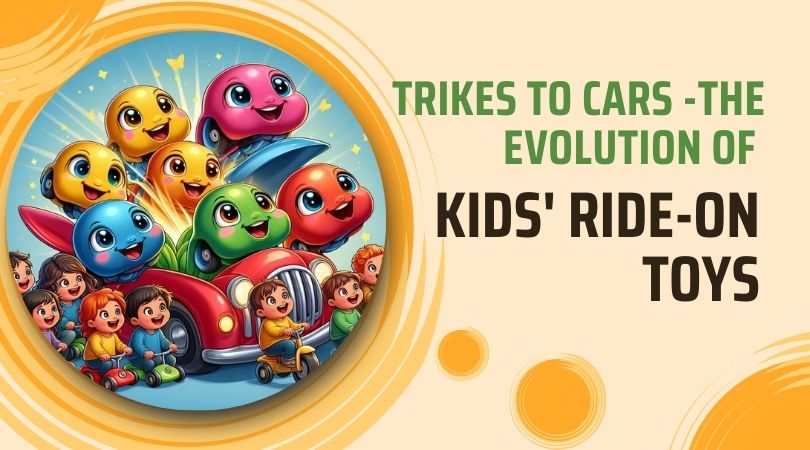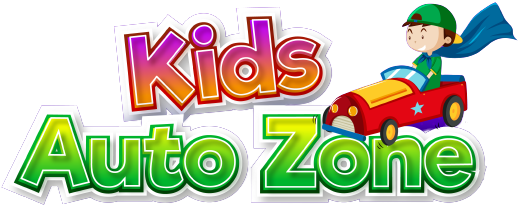
Aug 12 , 2024
From Trikes to Cars: The Evolution of Kids' Ride-On Toys
Children's toys have come a long way, especially when it comes to ride-on toys. From simple tricycles to sophisticated electric cars, the evolution of kids' ride-on toys reflects advancements in technology, changes in safety standards, and the growing focus on child development. This blog will explore the fascinating journey of ride-on toys, highlighting the significant milestones in their development and how they have transformed playtime for kids.
The Early Days: Tricycles and Pedal Cars

The history of ride-on toys dates back to the early 19th century when tricycles were introduced as a means of play and mobility for children. These early tricycles were simple, often made of wood or metal, and required children to pedal manually. Despite their basic design, they provided hours of fun and were among the first toys to encourage physical activity.
As the 20th century approached, pedal cars began to gain popularity. These miniature vehicles, often modeled after real cars, were made of metal and featured intricate details like working headlights and chrome accents. Pedal Cars quickly became a status symbol among children, and manufacturers started producing various models to cater to the growing demand. These early ride-on toys were more than just playthings; they were a child's first taste of independence and adventure.
The Rise of Plastic and Battery-Powered Toys

The 1950s and 1960s marked a significant shift in the design and production of ride-on toys. The introduction of plastic as a primary material revolutionized the toy industry. Plastic ride-on toys were lighter, more durable, and could be produced in various shapes and colors. This era also saw the advent of battery-powered ride-on toys, which added a new dimension to playtime.
Battery-powered ride-on cars quickly became the must-have toy for kids. These vehicles could move forward, reverse, and even steer, providing a more realistic driving experience. The ability to mimic real cars made them a favorite among children, and their popularity soared. Parents appreciated these toys because they were safer than pedal cars and required less physical effort, making them suitable for younger children.
The Modern Era: Electric Ride-On Cars and Beyond

The 21st century brought further advancements in the design and functionality of kids' ride-on toys. Today, electric ride-on cars are the pinnacle of toy technology, offering features that were once unimaginable. These vehicles come equipped with remote controls for parental supervision, realistic engine sounds, working LED lights, MP3 players, and even Bluetooth connectivity.
One of the most significant developments in recent years is the focus on safety. Modern ride-on toys are designed with safety features such as seat belts, soft-start technology, and automatic braking systems. These advancements ensure that children can enjoy their playtime while parents have peace of mind.
In addition to cars, the variety of ride-on toys available today is staggering. From motorcycles and ATVs to trucks and tractors, there's a ride-on toy for every child's interest. The materials used have also evolved, with high-quality plastics and durable rubber tires providing a smooth and safe ride. Moreover, eco-friendly options are now available, reflecting the growing concern for sustainability.
The Benefits of Ride-On Toys in Child Development
While the evolution of ride-on toys is fascinating, it's essential to understand the benefits these toys offer in child development. Ride-on toys are not just about fun; they play a crucial role in developing various skills and abilities in children.
- Physical Development: Ride-on toys promote physical activity, helping children develop their gross motor skills. Whether pedaling a tricycle or steering an electric car, kids engage in movements that strengthen their muscles and improve their coordination and balance.
- Cognitive Skills: Navigating a ride-on toy requires problem-solving and decision-making. Children learn to assess their surroundings, make quick decisions, and develop spatial awareness. These cognitive skills are essential as they grow and begin to explore the world around them.
- Social Interaction: Ride-on toys encourage social play. Whether it's a group of kids racing their cars or taking turns on a tricycle, these toys promote sharing, cooperation, and communication. Social interaction at a young age is vital for developing strong interpersonal skills.
- Confidence and Independence: There's nothing quite like the feeling of freedom a child experiences when they hop on a ride-on toy. Whether it's a trike or an electric car, these toys give children a sense of independence and confidence as they navigate their world.
Choosing the Right Ride-On Toy

With the plethora of options available today, choosing the right ride-on toy for your child can be overwhelming. Here are some tips to help you make the best choice:
- Age Appropriateness: Ensure the toy is suitable for your child's age and size. Manufacturers usually provide age recommendations, but it's essential to consider your child's abilities and comfort level as well.
- Safety Features: Look for toys with safety features like seat belts, soft-start technology, and parental remote controls. These features can make a significant difference in ensuring your child's safety during playtime.
- Durability: Invest in a ride-on toy made of high-quality materials that can withstand rough play. Durability is key to ensuring the toy lasts and remains safe for extended use.
- Interest and Preferences: Consider your child's interests when selecting a ride-on toy. If they love cars, an electric car might be the perfect choice. For children who enjoy outdoor adventures, an ATV or tractor might be more suitable.
- Battery Life and Charging: For battery-powered toys, check the battery life and charging time. Longer battery life means more playtime, which is crucial for keeping your child engaged.
The Future of Ride-On Toys

As technology continues to advance, the future of kids' ride-on toys looks promising. We can expect even more realistic designs, enhanced safety features, and the integration of smart technology. Imagine a ride-on car that can be programmed to follow a specific route or one that interacts with other toys for a more immersive play experience.
Moreover, with the growing emphasis on sustainability, manufacturers are likely to develop more eco-friendly options, using recycled materials and energy-efficient technologies. The focus on child development will also continue to drive innovation, with toys that offer educational benefits alongside entertainment.
Conclusion
From the humble tricycle to the sophisticated kids electric cars of today, the evolution of kids' ride-on toys is a testament to the advancements in technology and child development. These toys have not only provided endless hours of fun but have also played a crucial role in shaping the physical, cognitive, and social skills of generations of children. As we look to the future, it's exciting to imagine what new innovations will bring to this beloved category of toys.
